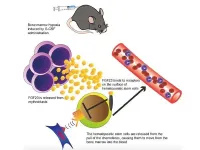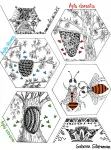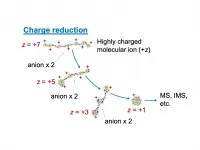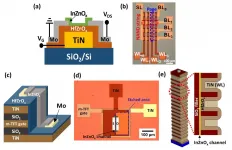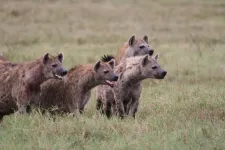(Press-News.org) "The real voyage of discovery consists not in seeking new landscapes, but in having new eyes."
Scientists would vouch for this statement because scientific pursuit has the habit of offering chance discoveries if we think about things differently.
In the lab of Arati Ramesh at the NCBS, the team loves to spy on the structure and sequence of Ribonucleic acids (RNAs; molecules that decrypt an organism's genetic code into protein messages). During one such instance, graduate students in Arati's lab were peering at a family of nickel and cobalt (NiCo RNAs) sensing bacterial RNAs that have a clover leaf-like structure. While sifting through this dataset, they noticed a set of RNAs that had retained this overall cloverleaf architecture but were subtly different. Upon chasing these 'variants', they realized that the 'NiCo-like RNAs' were in fact anchored in genomic turfs that were close enough to regulate iron-related enzymes and transporters. Could these NiCo look-alikes then be metalloregulators? Maybe of iron (Fe2+)?
To figure this out, the team kept NiCo-like RNA and Fe2+ in two separate cages separated by a membrane that only allows Fe2+ to bleed through. The experimental outcome revealed without a doubt that these RNAs enticed Fe2+ towards their chamber. Their guess was proven right and thus came the discovery of Sensei - short for Sense iron.
In their recent study, where the researchers describe the Sensei, they show that it acts like a riboswitch in the presence of iron. Upon binding iron, it undergoes a structural change to spur protein synthesis of the adjoining iron-related genes.
So, what is so fascinating about an iron sensing RNA?
Well, there are two parts to this answer. Firstly, iron is essential for many cellular processes and often acts as an accompaniment to chemical reactions in cells. If iron concentration is tipped off balance, it can reach toxic levels and perplex cells. Thus is it important for cells to be able to sense iron.
"Particularly, disease-causing pathogenic bacteria need to have the ability to sense iron so that they can be vigilant around heme-rich host tissues," explains Siladitya, the lead author.
Secondly, proteins have been the forerunners in iron sensing. Whereas the proverbial role of RNAs has been to act like embers in a pile of coal - waiting to translate into strings of amino acids. Even though the past few decades have seen a sea of change in this definition, the finding that biomolecules as delicate and transient as RNAs can detect iron comes as a revelation.
"This discovery puts RNAs in the limelight for sensing fundamentally important cellular metabolites like iron," says Arati. In fact, she further explains that it is the ability to adopt complex folds and structures that give RNAs their flexibility to interact with a plethora of molecules ranging from vitamins to metals.
Now, such a discovery commands high scrutiny. So, to check if Sensei is indeed a truthful sensor of iron, the team tested if the RNA was able to bind iron in the midst of a deluge of other molecules. True to its name, Sensei was a master. No matter what metal ions were present in the mix, Sensei was uncompromising and always chose to bind Fe2+ - making it one of the finest and strongest metalloregulatory RNAs discovered so far.
The question then was - what happens when Sensei binds iron? At the structural scale, the iron-bound RNA transforms itself and adopts a 'pose' that favours protein translation. In fact, it opens up its structure such that iron-related genes present in close genomic proximity can be rendered into proteins.
With this information in hand, the researchers then turned into crafty engineers. They tweaked the sequence of the RNA and identified the parts in the clover leaf-like structure that may bind iron. Then, they went one step further and made a small change in the RNA sequence which shifted the competence of RNA from sensing iron to now detect nickel and cobalt.
"This nanoscale engineering of iron sensing that we demonstrate, will hopefully set the stage for designing iron-biosensors which could be of use to both bacterial biology and biomedicine," explains Arati.
This story is as much about discovery by serendipity, as it is about what the discovery has taught us - the versatility of RNA, the unbending specificity behind an RNA's frail structure and its ability to sense something as fundamental as iron. What better way to honour it than by calling it Sensei, meaning teacher?
INFORMATION:
A Kobe University research group including graduate student ISHII Shinichi and Associate Professor KATAYAMA Yoshio (both of the Department of Hematology, Graduate School of Medicine) have discovered that fibroblast growth factor-23 (FGF23) produced by erythroblasts (cells that are the precursors of red blood cells) promotes the movement (mobilization) of hematopoietic stem cells (*1) into the peripheral blood. Up until now, FGF23 has been known for the role it plays in the kidneys as a hormone which regulates phosphate concentrations throughout the body.
It is hoped that this discovery will enable new strategies to be developed for harvesting hematopoietic ...
It is early in the morning. Ebi and his colleagues try not to twitch as they stare intently at a rectangular box filled with sugary treats. These aren't for them, but for the honey bees that they study. The tiny buzzers toggle between the sugar 'feeder' and the hive, which are a few metres apart. Interestingly, the bees that visit the feeder aren't secretive about this new found food source. They graciously advertise its location to their nest mates and over time more bees are seen buzzing to the feeder.
This behavior has been observed and researched for decades; but still, the question of how bees communicate within the noisy quarters ...
Mass spectrometers (MS) have become essential tools in chemistry and biology laboratories. The ability to quickly identify the chemical components in a sample allows them to take part in a diverse array of experiments, including radiocarbon dating, protein analysis, and monitoring drug metabolism.
MS instruments work by giving the analyte molecules an electric charge, and shooting them through a region of space with a uniform electric field, which curves their trajectory into a circle. The radius of the circle, which depends on the ratio of the molecule's mass to its charge, is detected and compared with known samples. Because the method can only measure this ratio, not the mass itself, excess charges can lead to inaccurate or ambiguous results.
Now, a team of researchers lead ...
"Stripy zebra, spotty leopard, ...". Kids never become bored pinpointing animals based on their unique body patterns. While it is fascinating that living creatures develop distinct patterns on their skin, what may be even more mysterious is their striking similarity to the skin of frozen liquid metals.
Pattern formation is a classic example of one of nature's wonders that scientists have pondered for centuries. Around 1952, the famous mathematician Alan Turing (father of modern computers) came up with a conceptual model to explain the pattern formation process of a two-substance system. Such patterns are also called Turing patterns thereafter.
Pattern formation is also commonly adopted by manmade systems and this is especially true in the ...
Fungi are among the world's oldest and most tenacious organisms. They are now showing great promise to become one of the most useful materials for producing textiles, gadgets and other construction materials. The joint research venture undertaken by the University of the West of England, Bristol, the U.K. (UWE Bristol) and collaborators from Mogu S.r.l., Italy, Istituto Italiano di Tecnologia, Torino, Italy and the Faculty of Computer Science, Multimedia and Telecommunications of the Universitat Oberta de Catalunya (UOC) has demonstrated that fungi possess ...
The compulsory collection of DNA being undertaken in some parts of the world is not just unethical, but risks affecting people's willingness to donate biological samples and thus contribute to the advancement of medical knowledge and the development of new treatments, says a paper in the European Journal of Human Genetics, published online* today [18 January 2021].
Citing abuses being carried out in China, Thailand, and on the US/Mexico border, the authors1 call on scientific journals to reexamine all published papers based on databases that do not meet accepted standards of ethical approval, and demand an end to collaborations between academic institutions worldwide and those in countries carrying out unethical DNA collections. ...
As we enter the era of superintelligence and hyper-connected Fourth Industrial Revolution, the importance of high-density and high-performance memory is greater than ever. Currently, the most widely used NAND flash memory has issues of high power consumption, slow operation speed, and vulnerability to repetitive use since it relies on the charge trap effect to store information. To this, a POSTECH research team has recently demonstrated a ferroelectric memory that exceedingly surpasses the performance of the conventional flash memory in terms of operation speed, power consumption, and device reliability.
A POSTECH research team - led by Professor Jang-Sik Lee, and Ph.D. candidates Min-Kyu Kim and Ik-Jyae Kim of the Department ...
Maxwell equations govern the evolution of electromagnetic fields with light being a particular solution of these equations in spaces devoid of electric charge. A new study published in EPJ C by Alexei Morozov and Nikita Tselousov, from the Moscow Institute of Physics and Technology and the Institute of Transmission Problems, Russia, respectively, details peculiar solutions to the Maxwell equations--so-called Maxwell knots. The research could have applications in the fields of mathematical physics and string theory.
"We usually think of light as the plane waves. It was a breakthrough when ...
Two giant radio galaxies have been discovered with South Africa's powerful MeerKAT telescope. These galaxies are thought to be amongst the largest single objects in the Universe. The discovery has been published today in Monthly Notices of the Royal Astronomical Society.
Whereas normal radio galaxies are fairly common, only a few hundred of these have radio jets exceeding 700 kilo-parsecs in size, or around 22 times the size of the Milky Way. These truly enormous systems are dubbed 'giant radio galaxies'.
Despite the scarcity of giant radio galaxies, the authors found two of these cosmic beasts in a remarkably small patch of sky.
Dr Jacinta Delhaize, a Research Fellow at the ...
Scientists from the Leibniz Institute for Zoo and Wildlife Research (Leibniz-IZW) have found that interacting with other males is more "stressful" for low-ranking than for high-ranking male spotted hyenas. This restricts the time and energy low-ranking males can invest in courting the most desirable females and is therefore a key factor for their lower reproductive success than their high-ranking rivals. This mechanism seems to be more important in determining the number and quality of offspring than physical traits such as attractiveness and fighting ability. These insights were possible owing to a combination of extensive field and lab work - over 20 years of searching and identifying thousands ...
